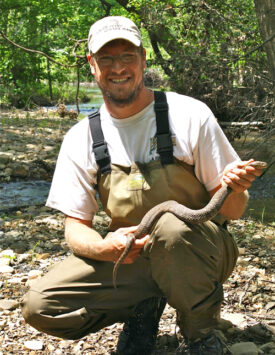Representative Publications:
Willson, J.D. and C.T. Winne. 2016. The predatory role of aquatic snakes in isolated wetlands: A case study in evaluating functional roles of secretive species. Journal of Zoology, London 298:266-273.
Kern, M. M., Guzy, J. C., Lovich, J. E., Gibbons, J. W., & Dorcas, M. E. 2015. Relationships of maternal body size and morphology with egg and clutch size in the diamondback terrapin, Malaclemys terrapin (Testudines: Emydidae). Biological Journal of the Linnean Society 177:295-304.
DeGregorio, B.†, S.J. Chiavacci, P.J. Weatherhead, J.D. Willson, T.J. Benson, and J.H. Sperry. 2014. Snake predation on North American bird nests: culprits, patterns, and future directions. Journal of Avian Biology 45:001-009.
DeGregorio, B.†, J.D. Willson, M.E. Dorcas and J.W Gibbons. 2014. Commercial value of amphibians produced from an isolated wetland. American Midland Naturalist 172:200-204.
Guzy, J.C., Price, S.J., and Dorcas, M.E. 2014. Using multiple methods to assess detection probabilities of riparian-zone anurans: implications for monitoring. Wildlife Research 41:243-257.
Witczak, L.R, Guzy, J.C., Price, S.J., and Dorcas, M.E. 2014. Temporal and spatial variation in survivorship of diamondback terrapins (Malaclemys terrapin). Chelonian Conservation and Biology 13:146-151.
Durso, A.M. and J.D. Willson. 2013. Habitat influences diet overlap in aquatic snake assemblages. Journal of Zoology, London 291:185-193.
Underwood, E.B., S. Bowers, J.C. Guzy, J.E. Lovich, C.A. TAylor, J.W. Gibbons, and M.E. Dorcas. 2013. Sexual dimorphism and feeding ecology of Diamondbacked terrapins (Malaclemys terrapin). Herpetologica 69:397-404.
Hopkins, B.C., S.Y. Chin, J.D. Willson, and W.A. Hopkins. 2013. Like mother, like offspring: maternal and offspring wound healing correlate in snakes. Journal of Experimental Biology 216:2545-2547.
Willson, J.D., and W.A. Hopkins. 2013. Beyond the wetland: evaluating the effects of anthropogenic stressors on source-sink dynamics in pond-breeding amphibians. Conservation Biology 27:595-604.
Hopkins, B.C., W.A. Hopkins, D.K. Jones†, and J.D. Willson. 2013. Mercury exposure is associated with negative effects on turtle reproduction. Environmental Science and Technology 47:2416-2422.
Drewett, D.V.V.,J.D. Willson, D. A. Cristol, S.Y. Chin, and W.A. Hopkins. 2013. Inter- and intra-specific variation in mercury bioaccumulation by snakes inhabiting a contaminated river floodplain. Environmental Toxicology & Chemistry 32:1178-1186.
Chin, S.Y., J.D. Willson, D. A. Cristol, D.V.V. Drewett, and W.A. Hopkins. 2013. High levels of maternally transferred mercury do not affect reproductive output or embryonic survival of northern watersnakes (Nerodia sipedon). Environmental Toxicology & Chemistry 32:619-626.
Chin, S.Y., J.D. Willson, D. A. Cristol, D.V.V. Drewett*, and W.A. Hopkins. 2013. Altered behavior of neonatal northern watersnakes (Nerodia sipedon) exposed to maternally transferred mercury. Environmental Pollution 176:144-150.
Willson, J.D., W.A. Hopkins, C.M. Bergeron, and B.D. Todd. 2012. Making leaps in amphibian ecotoxicology: Translating individual-level effects of environmental contaminants to population viability. Ecological Applications 22:1791-1802.
Reed, R.N., J.D. Willson, M.E. Dorcas, and G.H. Rodda. 2012. Ecological correlates of invasion impact for Burmese pythons in Florida. Integrative Zoology 7:254-270.
Dorcas, M.E., J.D. Willson, R.N. Reed, R.W. Snow, M.R. Rochford, M.A. Miller, W.E. Meshaka, Jr., P.T. Andreadis, F.J. Mazzotti, C.M. Romagosa, and K.M. Hart. 2012. Severe mammal declines coincide with python proliferation in Everglades National Park. Proceedings of the National Academy of Sciences – USA 109:2418-2422. (Cover Aritcle)
Todd, B. D., J.D. Willson, C. M. Bergeron, and W. A. Hopkins. 2012. Do effects of mercury in larval amphibians persist after metamorphosis? Ecotoxicology 21:87-95.
Willson, J.D. and W. A. Hopkins. 2011. Prey morphology constrains the feeding ecology of an aquatic generalist predator. Ecology 92:744-754.
Willson, J. D., C. T. Winne, and B. T. Todd. 2011. Ecological and methodological factors affecting detectability and population estimation in elusive species. Journal of Wildlife Management 75:36-45.

